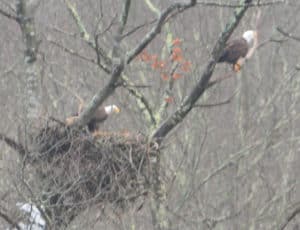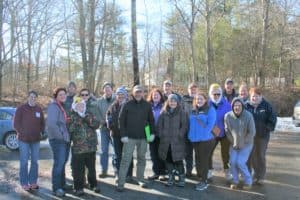
Survey Proves Eagles Love The Last Green Valley

Some of the volunteers for the 2018 Midwinter Eagle Survey held Jan. 13, 2018. Photo by Wendy Brenna (far right).
For the eighth year The Last Green Valley assisted the Connecticut Department of Energy and Environmental Protection in its Midwinter Eagle Survey. The Last Green Valley’s Chief Ranger, Bill Reid, organizes the group of volunteers in the 26 Connecticut towns of the National Heritage Corridor.
The Last Green Valley, Inc., (TLGV) is the non-profit charged with promoting and advocating for The Last Green Valley National Heritage Corridor’s unique resources.
On Jan. 13, 29 volunteers surveyed 31 locations. The number of volunteers was down due to weather concerns. Despite decreased participation, the number of eagle sightings increased. There were 26 sightings of eagles along the Quinebaug and Shetucket rivers and several lakes and ponds, up from 12 sightings the year before.
The sightings included adult bald eagles, some of which are known to nest in the national heritage corridor, juvenile bald eagles and at least one juvenile golden eagle.
“This is a great example of citizen science,” said TLGV Chief Ranger Bill Reid. “People who love and enjoy the region come together to document the eagles. These birds are good indicators of the health of our waterways and that is critical to all of us.”
Reid said TLGV began participating in the survey in 2010 as a way to draw attention to the wonderful attributes of the National Heritage Corridor while showing in a tangible way how the organization’s work on water quality has improved the health of area waterways, making it hospitable to the bald eagle once again.
The CT Department of Energy and Environmental Protection will crunch the information gathered by volunteers to determine the number of individual birds in the area. The detailed data reported by volunteers, such as exact time, location, and movement patterns are all vital pieces of the puzzle.
Nationally, the program is a project of the U.S. Geological Survey, Biological Resources Division. Teams across the country observe on the same date and during the same hours to make the Midwinter Eagle Survey a national, state and regional snapshot of the health of the eagle population. Some states, such as Massachusetts, do not participate in the Midwinter Eagle Survey but conduct their own nest surveys in the spring.
The Last Green Valley National Heritage Corridor is green by day and dark by night. It is a National Heritage Corridor with a rich history in a surprising rural landscape in the coastal sprawl between Boston and Washington D.C. Still 77 percent forest and farm, The National Heritage Corridor is the last swath of dark night sky in the nation’s most populated region. The Last Green Valley, Inc. works for you to ensure that together we can care for, enjoy and pass on The Last Green Valley.
Get Connected
Sign up for our newsletter
"*" indicates required fields



